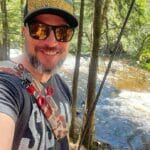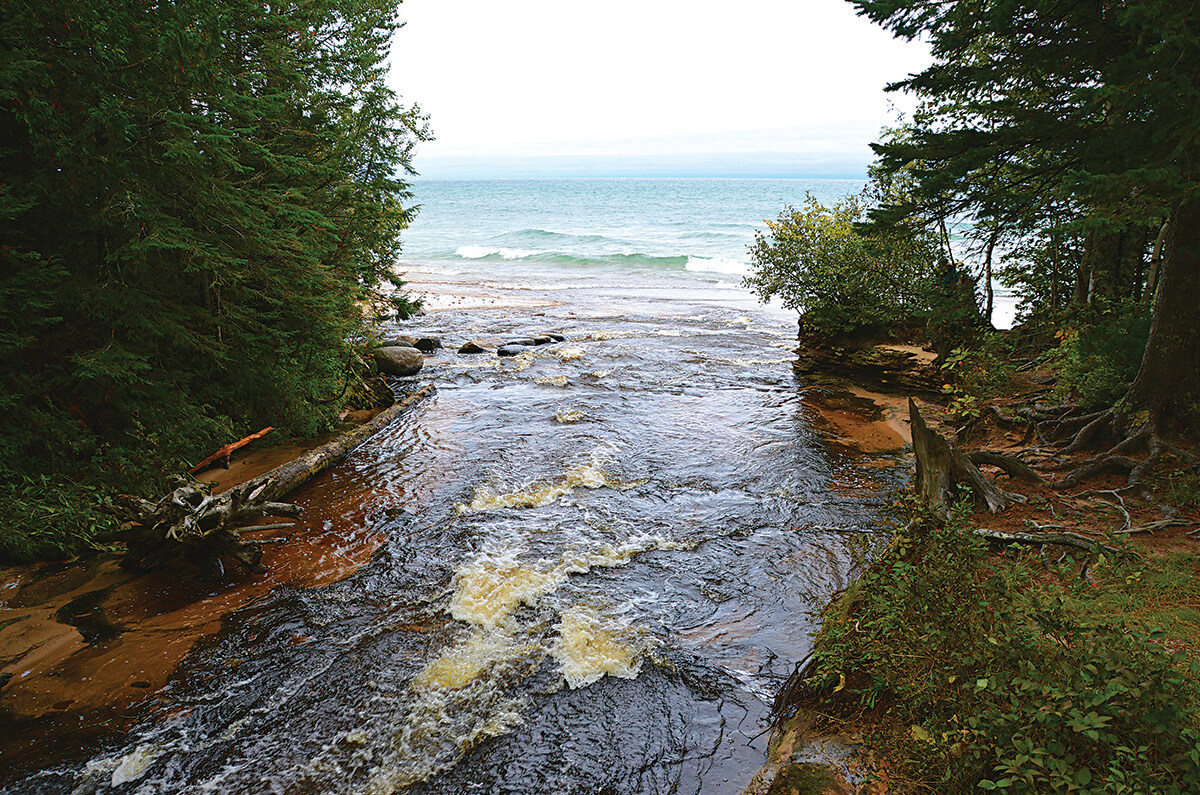Jumpstarting brook trout restoration on Lake Superior
Veins of iron and copper drew immigrants to Michigan’s Upper Peninsula more than a century ago. Today, veins of blue flowing into Lake Superior draw anglers to prospect for remnant populations of coaster brook trout trying to survive in this century after being nearly extirpated over the past two.
Coaster brook trout are adfluvial brook trout that spend part of their lives in the Great Lakes, notably Lake Superior, and part in lake tributaries. Scientists do not consider them to be genetically distinct from inland brook trout—these are still Salvelinus fontinalis—but they grow much larger, often topping 20 inches by foraging in the big lake and returning to spawn in tributaries or on shallow rocky shoals in the lake.
The first time Chris Adams caught a coaster brook trout, it was a surprise. He was fishing a muddler minnow for native brook trout along Lake Superior’s southern shoreline when a 17-inch coaster put a serious bend in his 3-weight. “They can get silvered up like a steelhead in the spring,” he explained, “and they fight like something from the big lake.”
When it comes to coaster brook trout, Adams is both an angler and an academic, searching for the Great Lakes’ most mysterious native fish with both a fly rod and radio monitoring equipment at hand.
As part of his 2020 Ph.D. research, he and a team from Michigan Technological University in Houghton used PIT tags—passive integrated transponders inserted inside fish that register when they pass near an in-stream receiver—to confirm a previously undocumented population of coaster brook trout in the Pilgrim River, a short drive from the campus where his doctoral advisor, Casey Huckins, leads a lab for coaster research and habitat restoration.
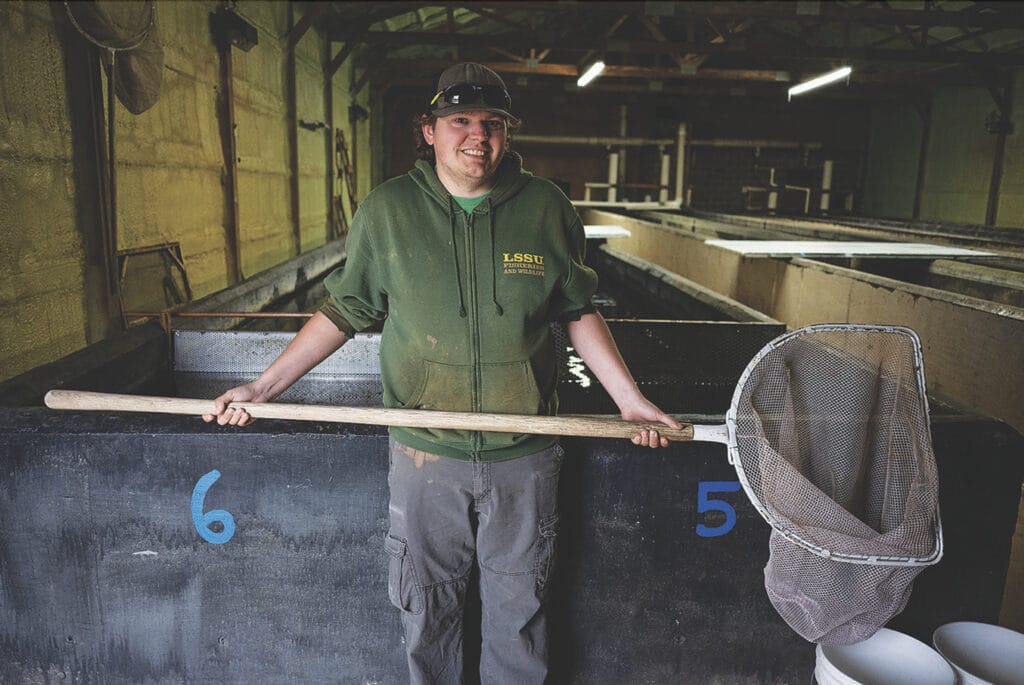
The Pilgrim River discovery was significant, because the thing we know most right now about coaster brook trout is how much we don’t know: Where they live, where they go, what makes them behave as coasters, what’s limiting their recovery and what we can do about it.
Overfishing and habitat degradation from 19th century logging practices reduced populations to the point that by 1865 they were considered “fished out” in Lake Superior waters near Marquette. They survive in tributaries in Ontario, Minnesota, Wisconsin and Michigan. In the Upper Peninsula, the Salmon Trout River is a stronghold.
The Great Lakes Fisheries Commission launched a coaster brook trout restoration plan for Lake Superior in 2003. However, efforts to study and recover coasters since then have crashed ashore and receded like Lake Superior waves, with periods of intense activity followed by lulls in interest and funding.
Now, it’s getting a fresh lift from Trout Unlimited, which identified the coaster brook trout tributaries along the southern Lake Superior coastline as one of its Priority Waters. With Bipartisan Infrastructure Law funding via the National Oceanic and Atmospheric Administration, TU is working with tribal nations, state and federal agencies and local chapters to identify and overcome physical, scientific and regulatory barriers to understanding and restoring coaster brook trout.
Troy Zorn works on coaster restoration on the Upper Peninsula, which he calls home. As a fisheries research biologist for the Michigan Department of Natural Resources, he has spearheaded experimental coaster brook trout regulations with a 20-inch minimum size limit on eight Lake Superior tributaries in 2014, following the success of similar regulations in Minnesota. These are aimed at protecting coasters from unwitting angling pressure.
“Where we have coaster populations in Michigan are places that are not heavily fished: Isle Royale, the Salmon-Trout River, portions of the Pilgrim River,” Zorn said.
To solve the problem of identifying coasters living alongside non-migratory brook trout in tributary streams, he is analyzing a stable isotope composition of fin clips from captured brook trout to determine if they have been foraging in Lake Superior. The goal is to develop an inexpensive, non-lethal technique for documenting coaster migrations and distinguishing which brook trout are coasters and which are not.
Henry Quinlan is a fishery biologist for the U.S. Fish and Wildlife Service, which has helped implement the 2003 coaster restoration plan and maintains a hatchery brood stock from Isle Royale for ongoing reintroduction efforts. He sees progress in coaster restoration where protective regulations are in place and where high-quality brook trout habitat exists in tributaries close to the Lake Superior coastline.
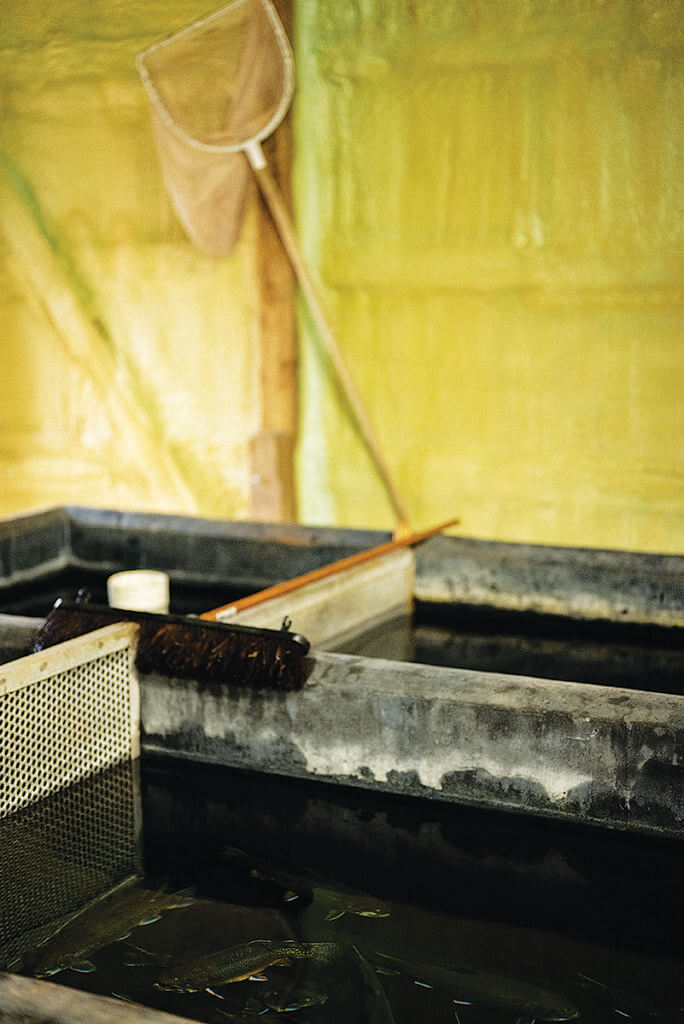
“A healthy brook trout population will result in better likelihood of coaster behavior,” he said, explaining that where good habitat exists close to the lake, the larger brook trout population that supports may be spawning some that seek additional food in Lake Superior.
Those questions can be answered by monitoring, which is why TU is assembling a coalition of partners to share coaster monitoring practices, insights and needs.
“TU can provide value by bringing these agencies, groups and tribal nations together in a coalition for coaster restoration,” said Jake Lemon, TU’s monitoring and community science manager. “We also fill capacity gaps where they’re needed; by bringing the partners together, we can do the gap analysis and fill those gaps where needed to keep restoration moving forward.”
One of those partners is the Red Cliff Band of Lake Superior Chippewa. They have operated a coaster brook trout hatchery since 1996 on their reservation on Wisconsin’s northern Lake Superior coastline by the Apostle Islands.
“High importance is placed on being good stewards of the natural world and practicing traditional life ways, such as harvesting wild foods and rehabilitating and reintroducing historically abundant native fish species such as coaster brook trout,” said Ian Harding, fisheries biologist for the Red Cliff Band. He recently concluded a two-year PIT tag study tracking where their hatchery-released coasters go. Some migration occurs in spring, but also appears to be dependent on river conditions.
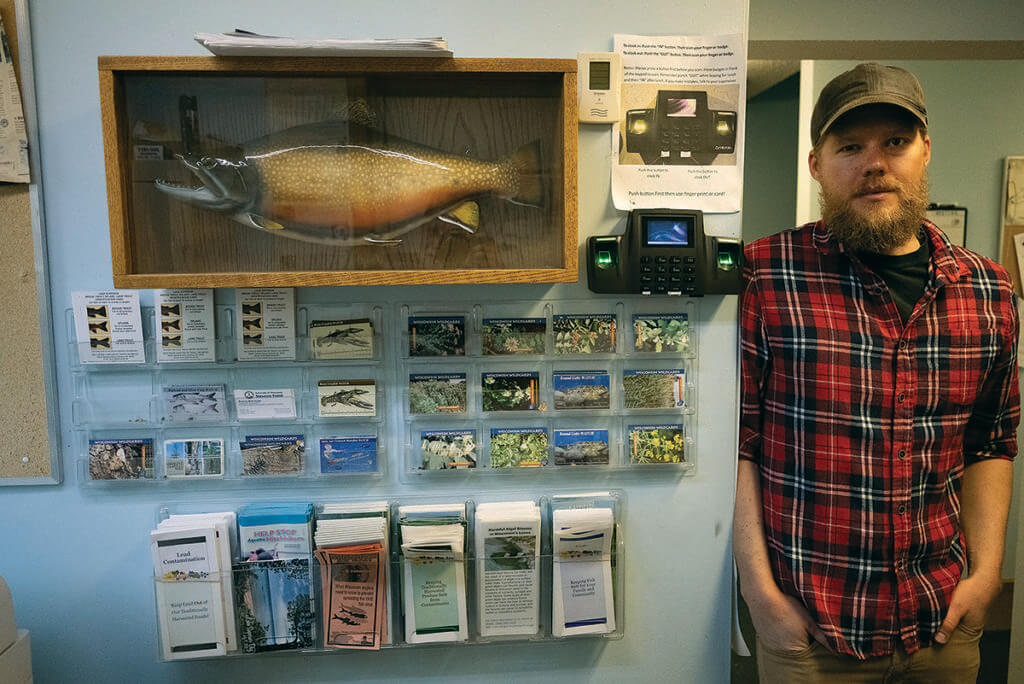
“We see about a 2 percent return of hatchery fish to the tributaries where we’ve set up monitors, with most of those going to Chicago Creek.”
Harding is planning stream habitat connectivity restoration on Chicago Creek using that monitoring data to drive conservation efforts and revise reintroduction strategies to get a higher return.
While monitoring like this will drive identification of future restoration efforts, some stream restoration projects are already being planned across coaster country through the NOAA grant.
Under a two-lane road on the Keweenaw Bay Indian Community reservation outside of L’Anse, Michigan, a century-old culvert channels Kalio Creek to the Silver River, one of the eight Lake Superior tributaries with Zorn’s experimental coaster brook trout regulations. The Kalio Creek culvert is the only fish passage barrier on the tributary.
On the eve of Michigan’s trout opener in late April, Erin Johnston, the wildlife and habitat section lead for the Keweenaw Bay Indian Community, looked over the road crossing with Sarah Topp, TU’s Upper Peninsula stream restoration manager.
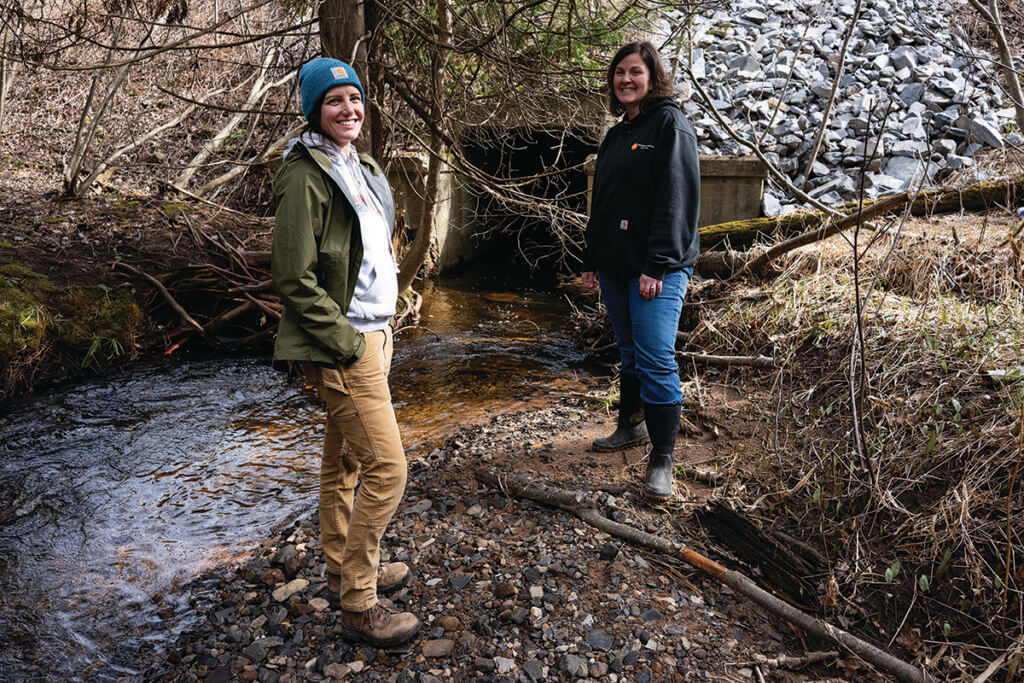
“This culvert is both perched and a velocity barrier,” Johnston explained. “Replacing it will reconnect upstream habitat and promote resiliency for native brook trout.”
That’s what the tribe and TU are working together to do. The culvert has been a known fish access barrier since 2012, when the Fish and Wildlife Service flagged it as part of a Great Lakes road-stream crossing assessment. It shows its age with cracked concrete and exposed rebar. Some stream flow was visible, but at hotter times it can dry up completely and prevent brook trout access to cooler upstream reaches.
There has not been funding available to replace it—until now, Topp said. With the coaster brook trout streams now a TU Priority Water, staff in Michigan are looking to fund projects to support recovery, and agencies are responding.
Through the NOAA grant funded by the Bipartisan Infrastructure Law, Trout Unlimited is planning two more aquatic organism passage projects on Lake Superior tributaries in Michigan and six in Wisconsin. It’s just the start.
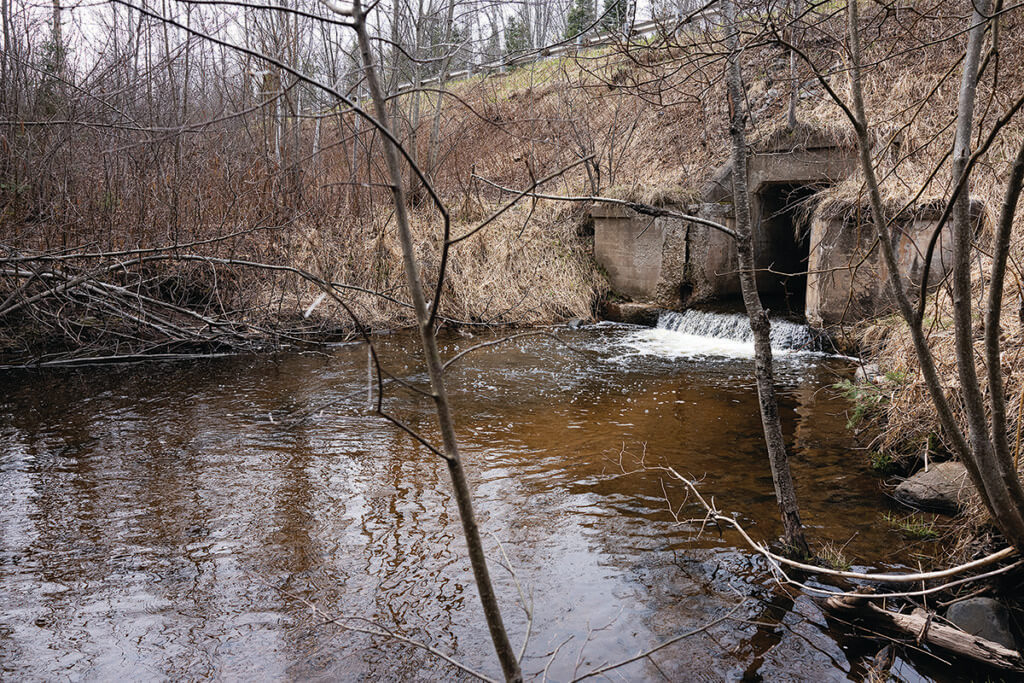
“Nobody knows, on paper, where all the coasters still are, nobody knows exactly what habitat needs they have, and we’re going to find hundreds of problem barriers in the Lake Superior watershed,” said Bryan Burroughs, executive director of the Michigan Council of Trout Unlimited.
Burroughs has waded the ebbs and flows of coaster recovery in the 16 years that he’s led Michigan TU. He views the unknowns about coasters as opportunities, not obstacles.
“The shared Priority Waters is a great way to say we’re going to figure out a way to recover coasters,” he said. “It’s going to be daunting to understand where they are, but it’s doable. They’re out there. We can get them back to fishable numbers.”
Chris Adams shares his optimism. He is now an adjunct professor at Michigan Tech and continues to expand coaster monitoring efforts, working with the U.S. Fish and Wildlife Service to tag coasters and monitor their movements in open water. He is also leading the Copper Country Chapter of Trout Unlimited, which supported his research and works to monitor stream temperatures and plant trees to help the newly confirmed coaster populations in the Pilgrim River. “The coming decade will be a critical time for coaster restoration in the Lake Superior watershed,” he said. “It’s easy to stay enthusiastic about these incredible fish, though, especially if you’ve caught one.”


